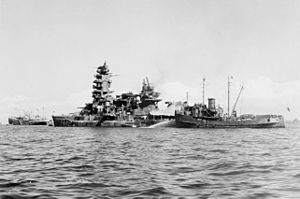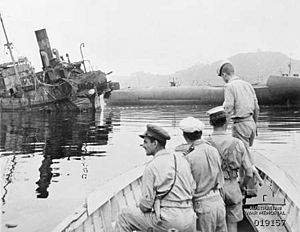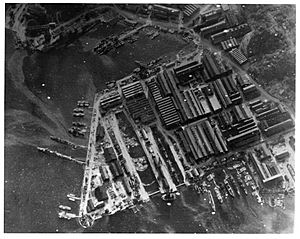Attack on Yokosuka facts for kids
Quick facts for kids Attack on Yokosuka |
|||||||
|---|---|---|---|---|---|---|---|
| Part of Pacific War, World War II | |||||||
 Japanese battleship Nagato in 1945 |
|||||||
|
|||||||
| Belligerents | |||||||
| Commanders and leaders | |||||||
| Units involved | |||||||
| Casualties and losses | |||||||
| 14 aircraft 18 aircrew killed |
1 destroyer 1 submarine 2 escort vessels sunk 1 battleship damaged 5 small ships damaged 43 aircraft destroyed 77 aircraft damaged |
||||||
The Attack on Yokosuka was a major air raid. It happened on July 18, 1945, during the final weeks of World War II. The United States Navy led this attack. Their main goal was to hit the Japanese battleship Japanese battleship Japanese battleship Nagato.
This famous battleship was docked at the Yokosuka Naval Arsenal in Tokyo Bay. American and British planes also attacked anti-aircraft guns and other ships nearby. They also targeted Japanese airfields around Tokyo.
Even though Nagato was only slightly damaged, the Allied planes caused a lot of harm. They sank a destroyer, a submarine, and two smaller escort ships. Five other small ships were also damaged. The Allied pilots also said they destroyed many Japanese planes and even some trains. However, Japanese anti-aircraft guns shot down 14 Allied planes.
Contents
Why the Attack Happened
In July 1945, the United States Third Fleet was very busy. This powerful fleet was led by Admiral William Halsey. They were carrying out many air raids and naval bombardments against targets in Japan.
The main attack force was called Task Force 38 (TF 38). Vice Admiral John S. McCain was in charge of it. This force had nine large aircraft carriers and six smaller ones. They also had many escort ships. Almost 1,000 aircraft were on board these carriers.
On July 10, TF 38 planes attacked airfields near Tokyo. They claimed to have destroyed 340 Japanese planes on the ground. After this, the Third Fleet attacked Hokkaido and northern Honshu on July 14 and 15. They sank many ships and destroyed 25 planes.
On July 16, the British Pacific Fleet (BPF) joined the Americans. The British force, called Task Force 37 (TF 37), had three aircraft carriers and their escort ships.
By July 1945, the Imperial Japanese Navy (IJN) was in a tough spot. Their big warships could not go to sea. They lacked fuel and faced constant danger from Allied planes and submarines. Most of these warships were hidden near the naval base at Kure.
However, the battleship Nagato and some smaller ships were at Yokosuka Naval Arsenal. This base is located in Tokyo Bay. Nagato was tied up next to a pier. It was covered in camouflage to make it harder to spot from the air.
Many of Nagato's guns had been removed. They were placed on nearby hills to protect the naval base. The battleship's engines were not running. It got power from a small support ship and a boiler on the pier. The destroyer Ushio was also nearby. It helped protect Nagato with its anti-aircraft guns.
Planning the Attack
Allied forces learned about Nagato's location from photos. These photos were taken during the July 10 raid on Tokyo. On July 16, Admiral Halsey and British Admiral Bernard Rawlings met. They planned new raids on the Tokyo area.
Halsey really wanted to sink the remaining Japanese warships. He especially wanted to sink Nagato. This ship had been Admiral Isoroku Yamamoto's main ship during the attack on Pearl Harbor in 1941.
Nagato was in a very well-defended harbor. So, the Allied planners knew that torpedo attacks would be too risky. They decided to use dive bombing instead. This meant planes would drop bombs while flying straight down. Because the land around the base was mountainous, there were only a few ways for the dive bombers to approach.
The Attack on Yokosuka
On July 17, the Allied fleet tried to attack Yokosuka. But bad weather and thick clouds stopped most of the planes. The few planes that reached Tokyo only hit airfields north of the city. They caused little damage.
The next day, July 18, the weather improved. At 11:30 AM, the air strikes began. British planes from TF 37 attacked airfields near Tokyo. However, one British carrier had fuel problems. So, it could only launch a few planes.
TF 38, the American force, focused on Yokosuka Naval Arsenal. Nagato was their main target. Some American planes also attacked Japanese airfields.
Hitting the Targets
The attack on Yokosuka started around 3:30 PM on July 18. The first wave of American planes attacked the anti-aircraft guns around the base. They were successful in silencing them.
Then, planes from VF-88 attacked Nagato with bombs. A 500-pound bomb hit the battleship's bridge. This killed the ship's commanding officer, Rear Admiral Otsuka Miki, and at least nine other men. Another 500-pound bomb hit near the officers' mess. This killed about 22 sailors and knocked out four anti-aircraft guns.
Only one other direct hit happened. A 5-inch shell or rocket hit the ship but did not explode. However, 60 bombs landed in the water near Nagato. This caused holes in her outer hull, letting 2,000 tons of water into the ship. By the time the attack ended at 4:10 PM, 35 of Nagato's 967 crew members had been killed. Overall, the damage to the ship was considered light.
Other Ships Attacked
American planes also attacked other ships at Yokosuka. The unfinished destroyer Yaezakura broke in half and sank after being bombed. The submarine I-372 was destroyed by another bomb. Luckily, its crew was ashore and safe.
Two escort ships and a torpedo boat were also sunk. Five other ships were damaged. These included the old destroyer Yakaze and training ships Fuji and Kasuga. The support ship Fukugawa Maru No. 7 and the destroyer Ushio were not damaged, even though they were close to Nagato.
The British and American planes that attacked airfields claimed to have destroyed 43 Japanese aircraft. They also damaged another 77. Pilots also reported destroying several railway locomotives. The Allies lost 12 U.S. Navy planes and two British Royal Navy planes. A total of 18 aircrew members were killed. The Allied pilots were disappointed they had not sunk Nagato.
What Happened Next

After the Yokosuka attack, the Allied fleet left Japan to refuel. Their next attacks were against the main Japanese fleet at Kure. These raids happened on July 24, 25, and 28. They sank three battleships, an aircraft carrier, and other warships. However, the Allies lost 133 planes and 102 aircrew. The Third Fleet and parts of the British Pacific Fleet continued to strike targets in Japan. This continued until the war ended on August 15, 1945.
After the attack on Yokosuka, Nagato's crew removed the dead and made small repairs. They also flooded some of the ship's tanks. This made it look like the ship had sunk. On August 2, Nagato was ordered to go to sea to stop an Allied force. But this order was canceled. The report of Allied ships turned out to be false.
When Japan surrendered on August 15, 1945, Nagato was the only Japanese battleship still floating. On August 30, the ship was given to the U.S. Navy. Nagato was later used as a target ship. This was for two atomic bomb tests at Bikini Atoll in July 1946. The ship finally sank there on July 29–30.
Images for kids



